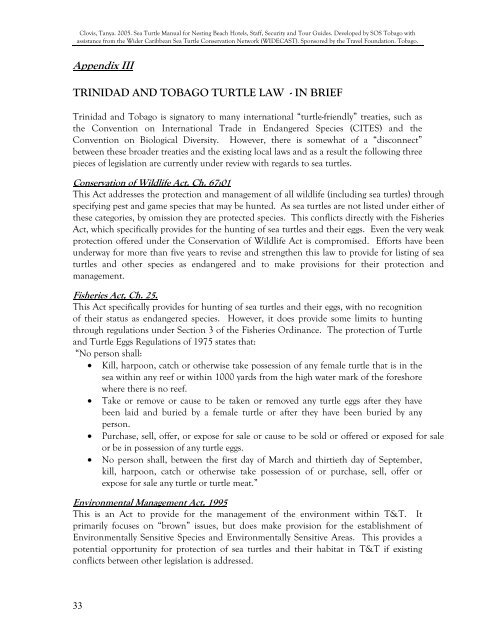Clovis, Tanya. - WIDECAST
Clovis, Tanya. - WIDECAST
Clovis, Tanya. - WIDECAST
Create successful ePaper yourself
Turn your PDF publications into a flip-book with our unique Google optimized e-Paper software.
<strong>Clovis</strong>, <strong>Tanya</strong>. 2005. Sea Turtle Manual for Nesting Beach Hotels, Staff, Security and Tour Guides. Developed by SOS Tobago with<br />
assistance from the Wider Caribbean Sea Turtle Conservation Network (<strong>WIDECAST</strong>). Sponsored by the Travel Foundation. Tobago.<br />
Appendix III<br />
TRINIDAD AND TOBAGO TURTLE LAW - IN BRIEF<br />
Trinidad and Tobago is signatory to many international “turtle-friendly” treaties, such as<br />
the Convention on International Trade in Endangered Species (CITES) and the<br />
Convention on Biological Diversity. However, there is somewhat of a “disconnect”<br />
between these broader treaties and the existing local laws and as a result the following three<br />
pieces of legislation are currently under review with regards to sea turtles.<br />
Conservation of Wildlife Act, Ch. 67:01<br />
This Act addresses the protection and management of all wildlife (including sea turtles) through<br />
specifying pest and game species that may be hunted. As sea turtles are not listed under either of<br />
these categories, by omission they are protected species. This conflicts directly with the Fisheries<br />
Act, which specifically provides for the hunting of sea turtles and their eggs. Even the very weak<br />
protection offered under the Conservation of Wildlife Act is compromised. Efforts have been<br />
underway for more than five years to revise and strengthen this law to provide for listing of sea<br />
turtles and other species as endangered and to make provisions for their protection and<br />
management.<br />
Fisheries Act, Ch. 25.<br />
This Act specifically provides for hunting of sea turtles and their eggs, with no recognition<br />
of their status as endangered species. However, it does provide some limits to hunting<br />
through regulations under Section 3 of the Fisheries Ordinance. The protection of Turtle<br />
and Turtle Eggs Regulations of 1975 states that:<br />
“No person shall:<br />
• Kill, harpoon, catch or otherwise take possession of any female turtle that is in the<br />
sea within any reef or within 1000 yards from the high water mark of the foreshore<br />
where there is no reef.<br />
• Take or remove or cause to be taken or removed any turtle eggs after they have<br />
been laid and buried by a female turtle or after they have been buried by any<br />
person.<br />
• Purchase, sell, offer, or expose for sale or cause to be sold or offered or exposed for sale<br />
or be in possession of any turtle eggs.<br />
• No person shall, between the first day of March and thirtieth day of September,<br />
kill, harpoon, catch or otherwise take possession of or purchase, sell, offer or<br />
expose for sale any turtle or turtle meat.”<br />
Environmental Management Act, 1995<br />
This is an Act to provide for the management of the environment within T&T. It<br />
primarily focuses on “brown” issues, but does make provision for the establishment of<br />
Environmentally Sensitive Species and Environmentally Sensitive Areas. This provides a<br />
potential opportunity for protection of sea turtles and their habitat in T&T if existing<br />
conflicts between other legislation is addressed.<br />
33
















